Assessment of the Interconnection for Multi-Transfer Facilities: A Perspective from Coupling Coordination
Abstract
:1. Introduction
2. Literature Review
2.1. MaaS and Transit Behavior
2.2. Transfer Integration Assessment
2.3. Application of Coupling Relationship
3. Methodology
3.1. Conception of DCC-MTF
3.2. Evaluation Model of DCC-MTF
3.2.1. Indicator of DCC-MTF by the Entropy Weight Method
3.2.2. Child Indicator of DCC-MTF
- (1)
- Diversity
- (2)
- Selectivity
- (3)
- Accessibility
- (4)
- Continuity
4. Application Example
4.1. Study Area Description
4.2. Analysis Results
4.2.1. Difference of a Single Indicator among All Transfer Facilities
4.2.2. Multivariable Clustering and Spatial Distribution Analysis
4.2.3. Difference of the Composite Indicator
5. Discussion
6. Conclusions
Author Contributions
Funding
Institutional Review Board Statement
Informed Consent Statement
Data Availability Statement
Conflicts of Interest
Glossary
| Symbol | Implication |
|---|---|
| The diversity indicator of transfer facility node i within the buffer zone | |
| The selectivity indicator of transfer facility node i within the buffer zone | |
| The accessibility indicator of transfer facility node i within the buffer zone | |
| The continuity indicator of transfer facility node i within the buffer zone | |
| The ratio of the number of transfer facility node i to the total number of transfer facility nodes | |
| The number of transfer facility node i by transport modes | |
| The ratio of the number of transfer facility node i to the maximum number of transfer facility nodes that are interchangeable | |
| The number of transfer facility nodes that are interchangeable with node i | |
| The maximum acceptable distance from transfer facility node i to all nodes k | |
| The average walking distance from transfer facility node i to all nodes k | |
| The ideal distance from transfer facility node i to all nodes k | |
| The frequency of the hardware connection carrier in this path for transfer facility node i | |
| The number of hardware connection carriers of type l in the path from transfer facility node i to j | |
| The weight value of the l-th type hardware connection carrier | |
| The number of turn occurrences in the path from transfer facility node i to j | |
| The weight constant of the cross point of the path | |
| i,j | Transfer facility node index, i∈N, j∈N |
| n | The maximum number of transfer facility node samples within the buffer zone |
| m | The maximum number of transfer facility node samples by transport modes within the buffer zone |
| l | The type index of the hardware connection carrier |
| u | The maximum number of hardware connection carrier types to node i |
| k | The transfer facility node index with hardware connection carriers to node i, k∈N |
| N | The total transfer facility nodes set within the buffer zone |
| T | The frequency set of each hardware connection carrier that passengers pass through in the same path |
References
- Makarewicz, C.; Németh, J. Are multimodal travelers more satisfied with their lives? A study of accessibility and wellbeing in the Denver, Colorado metropolitan area. Cities 2018, 74, 179–187. [Google Scholar] [CrossRef]
- Bhandari, K.; Advani, M.; Parida, P.; Gangopadhyay, S. Consideration of access and egress trips in carbon footprint estimation of public transport trips: Case study of Delhi. J. Clean. Prod. 2014, 85, 234–240. [Google Scholar] [CrossRef]
- Guo, Z.; Wilson, N.H.M. Assessing the cost of transfer inconvenience in public transport systems: A case study of the London Underground. Transp. Res. Part A Policy Pract. 2011, 45, 91–104. [Google Scholar] [CrossRef]
- Zhao, J.; Deng, W.; Song, Y. Ridership and effectiveness of bikesharing: The effects of urban features and system characteristics on daily use and turnover rate of public bikes in China. Transp. Policy 2014, 35, 253–264. [Google Scholar] [CrossRef]
- Fishman, E.; Washington, S.; Haworth, N. Bike share’s impact on car use: Evidence from the United States, Great Britain, and Australia. Transp. Res. Part D Transp. Environ. 2014, 31, 13–20. [Google Scholar] [CrossRef] [Green Version]
- Narayan, J.; Cats, O.; van Oort, N.; Hoogendoorn, S. Integrated route choice and assignment model for fixed and flexible public transport systems. Transp. Res. Part C Emerg. Technol. 2020, 115. [Google Scholar] [CrossRef]
- Martin, E.W.; Shaheen, S.A. Evaluating public transit modal shift dynamics in response to bikesharing: A tale of two U.S. cities. J. Transp. Geogr. 2014, 41, 315–324. [Google Scholar] [CrossRef] [Green Version]
- Akshay, V.; Stacey, R. Consumer preferences forMobility-as-a-Service(MaaS) in Australia. Transp. Res. Part A 2020, 117, 1–21. [Google Scholar] [CrossRef]
- Mulley, C.; Ho, C.; Balbontin, C.; Hensher, D.; Stevens, L.; Nelson, J.D.; Wright, S. Mobility as a service in community transport in Australia: Can it provide a sustainable future? Transp. Res. Part A 2020, 131, 107–122. [Google Scholar] [CrossRef]
- Smith, G.; Sochor, J.; Karlsson, I.C.M. Mobility as a Service: Development scenarios and implications for public transport. Res. Transp. Econ. 2018, 69, 592–599. [Google Scholar] [CrossRef]
- Polydoropoulou, A.; Pagoni, I.; Tsirimpa, A. Ready for Mobility as a Service? Insights from stakeholders and end-users. Travel Behav. Soc. 2020, 21, 295–306. [Google Scholar] [CrossRef]
- Tonnesen, A.; Knapskog, M.; Uteng, T.P.; Oksenholt, K.V. The integration of active travel and public transport in Norwegian policy packages: A study on ‘access, egress and transfer’ and their positioning in two multilevel contractual agreements. Res. Transp. Bus. Manag. 2020. [Google Scholar] [CrossRef]
- Oeschger, G.; Carroll, P.; Caulfield, B. Micromobility and public transport integration: The current state of knowledge. Trans. Res. Part D Transp. Environ. 2020, 89, 102628. [Google Scholar] [CrossRef]
- Mao, Z.; Ettema, D.; Dijst, M. Commuting trip satisfaction in Beijing: Exploring the influence of multimodal behavior and modal flexibility. Transp. Res. Part A Policy Pract. 2016, 94, 592–603. [Google Scholar] [CrossRef]
- Azimi, G.; Rahimi, A.; Lee, M.; Jin, X. Mode choice behavior for access and egress connection to transit services. Int. J. Transp. Sci. Technol. 2020. [Google Scholar] [CrossRef]
- Younes, H.; Nasri, A.; Baiocchi, G.; Zhang, L. How transit service closures influence bikesharing demand; lessons learned from SafeTrack project in Washington, D.C. metropolitan area. J. Transp. Geogr. 2019, 76, 83–92. [Google Scholar] [CrossRef]
- Kima, J.; Schmöckera, J.D.; Yu, J.W.; Choi, J.Y. Service quality evaluation for urban rail transfer facilities with Rasch analysis. Travel Behav. Soc. 2018, 13, 26–35. [Google Scholar] [CrossRef]
- Riggs, W.; Sethi, S.A. Multimodal travel behaviour, walkability indices, and social mobility: How neighbourhood walkability, income and household characteristics guide walking, biking & transit decisions. Local Environ. 2020, 25, 57–68. [Google Scholar] [CrossRef]
- Li, L.; Loo, B.P.Y. Towards people-centered integrated transport: A case study of Shanghai Hongqiao Comprehensive Transport Hub. Cities 2016, 58, 50–58. [Google Scholar] [CrossRef]
- Zhao, D.; Wang, W.; Li, C.; Ji, Y.; Hu, X.; Wang, W. Recognizing metro-bus transfers from smart card data. Transp. Plan. Technol. 2018, 42, 70–83. [Google Scholar] [CrossRef]
- Kumar, P.P.; Parida, M.; Swami, M. Performance Evaluation of Multimodal Transportation Systems. Procedia Soc. Behav. Sci. 2013, 104, 795–804. [Google Scholar] [CrossRef] [Green Version]
- MIMIC; European Commission. The Forth Framework Research and Technological Development Programme. Available online: https://cordis.europa.eu/programme/id/FP4 (accessed on 1 April 2022).
- Ho, C.Q.; Mulley, C.; Hensher, D.A. Public preferences for mobility as a service: Insights from stated preference surveys. Transp. Res. Part A Policy Pract. 2020, 131, 70–90. [Google Scholar] [CrossRef]
- Barabino, B.; Di Francesco, M.; Maternini, G.; Mozzoni, S. Offline framework for the diagnosis of transfer reliability by Automatic Vehicle Location Data. IEEE Intelligent Transportation Systems Magazine, 4 March 2021. [Google Scholar] [CrossRef]
- El-Geneidy, A.; Levinson, D.; Diab, E.; Boisjoly, G.; Verbich, D.; Loong, C. The cost of equity: Assessing transit accessibility and social disparity using total travel cost. Transp. Res. Part A Policy Pract. 2016, 91, 302–316. [Google Scholar] [CrossRef] [Green Version]
- Tahmasbi, B.; Kim, I. Multimodal accessibility-based equity assessment of urban public facilities distribution. Sustain. Cities Soc. 2019, 49, 101633. [Google Scholar] [CrossRef]
- Guzman, L.; Oviedo, D.; Cardona, R. Accessibility Changes: Analysis of the Integrated Public Transport System of Bogotá. Sustainability 2018, 10, 3958. [Google Scholar] [CrossRef] [Green Version]
- Cohen, T. Tools for addressing transport inequality: A novel variant of accessibility measurement. J. Transp. Geogr. 2020, 88, 102863. [Google Scholar] [CrossRef]
- Li, Y.; Zhou, Y.; Shi, Y.; Zhu, X. Investigation of a coupling model of coordination between urbanization and the environment. J. Environ. Manag. 2012, 98, 127–133. [Google Scholar] [CrossRef]
- Kai, Y.; Shuran, L.; Jiancun, G.; Lei, P. Research on the coupling degree measurement model of urban gas pipeline leakage disaster system. Int. J. Disaster Risk Reduct. 2017, 22, 238–245. [Google Scholar] [CrossRef]
- Tang, Z. An integrated approach to evaluating the coupling coordination between tourism and the environment. Tour. Manag. 2015, 46, 11–19. [Google Scholar] [CrossRef]
- Liu, W.; Zhan, J.; Zhao, F.; Wei, X.; Zhang, F. Exploring the coupling relationship between urbanization and energy eco-efficiency: A case study of 281 prefecture-level cities in China. Sustain. Cities Soc. 2021, 64, 102563. [Google Scholar] [CrossRef]
- Ducrot, R.; Le Page, C.; Bommel, P.; Kuper, M. Articulating land and water dynamics with urbanization: An attempt to model natural resources management at the urban edge. Comput. Environ. Urban Syst. 2004, 28, 85–106. [Google Scholar] [CrossRef]
- Pijanowski, B.C.; Tayyebi, A.; Doucette, J.; Pekin, B.K.; Braun, D.; Plourde, J. A big data urban growth simulation at a national scale: Configuring the GIS and neural network based Land Transformation Model to run in a High Performance Computing (HPC) environment. Environ. Model. Softw. 2014, 51, 250–268. [Google Scholar] [CrossRef]
- Gan, L.; Shi, H.; Hu, Y.; Lev, B.; Lan, H. Coupling coordination degree for urbanization city-industry integration level: Sichuan case. Sustain. Cities Soc. 2020, 58, 102136. [Google Scholar] [CrossRef]
- Song, Q.; Zhou, N.; Liu, T.; Siehr, S.A.; Qi, Y. Investigation of a “coupling model” of coordination between low-carbon development and urbanization in China. Energy Policy 2018, 121, 346–354. [Google Scholar] [CrossRef] [Green Version]
- Xing, L.; Xue, M.; Hu, M. Dynamic simulation and assessment of the coupling coordination degree of the economy-resource-environment system: Case of Wuhan City in China. J. Environ. Manag. 2019, 230, 474–487. [Google Scholar] [CrossRef]
- Shi, T.; Yang, S.; Zhang, W.; Zhou, Q. Coupling coordination degree measurement and spatiotemporal heterogeneity between economic development and ecological environment—Empirical evidence from tropical and subtropical regions of China. J. Clean. Prod. 2020, 244, 118739. [Google Scholar] [CrossRef]
- Weijs-Perrée, M.; Dane, G.; van den Berg, P.; van Dorst, M. A Multi-Level Path Analysis of the Relationships between the Momentary Experience Characteristics, Satisfaction with Urban Public Spaces, and Momentary-and Long-Term Subjective Wellbeing. Int. J. Environ. Res. Public Health 2019, 16, 3621. [Google Scholar] [CrossRef] [Green Version]
- Gao, P.; Wang, X.; Wang, H.; Cheng, C. A correction to the entropy weight coefficient method by Shen et al. for accessing urban sustainability. Cities 2020, 103, 102742. [Google Scholar] [CrossRef]
- Charles, C. Calculating the information content of an information process for a domain expert using Shannon’s mathematical theory of communication. Inf. Processing Manag. 1997, 33, 715–726. [Google Scholar]
- Saghapour, T.; Moridpour, S. The role of neighbourhoods accessibility in residential mobility. Cities 2019, 87, 1–9. [Google Scholar] [CrossRef]
- Arbués, P.; Baños, J.F.; Mayor, M. The spatial productivity of transportation infrastructure. Transp. Res. Part A Policy Pract. 2015, 75, 166–177. [Google Scholar] [CrossRef]
- Janoušková, S.; Hák, T.; Moldan, B. Global SDGs Assessments: Helping or Confusing Indicators? Sustainability 2018, 10, 1540. [Google Scholar] [CrossRef] [Green Version]
- Ochoa-Covarrubias, G.; Grindlay, A.L.; Lizarraga, C. Does the Mass Public Transport System Cover the Social Transport Needs? Targeting SDG 11.2 in Guadalajara, Mexico. Appl. Sci. 2021, 11, 7709. [Google Scholar] [CrossRef]
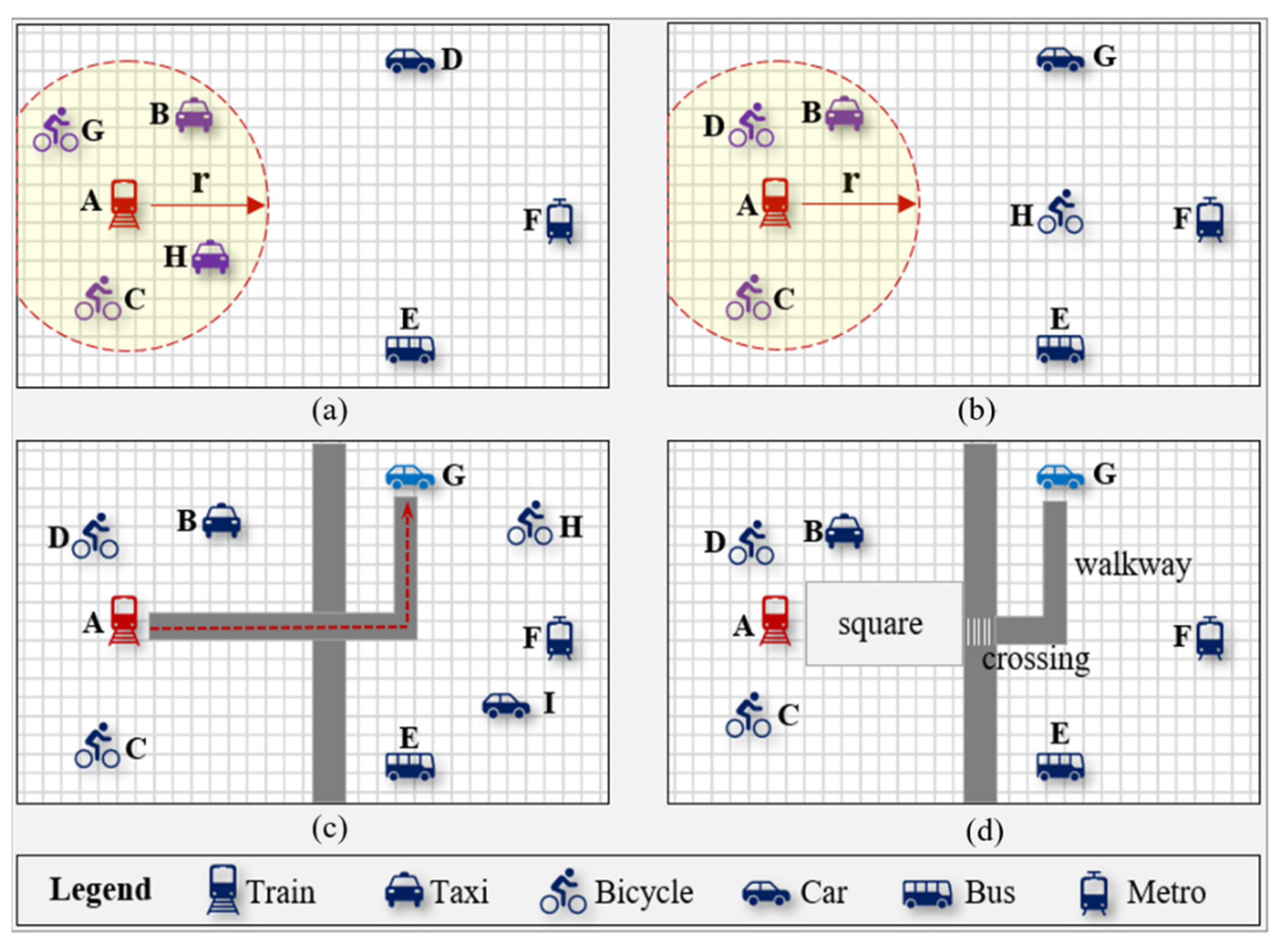
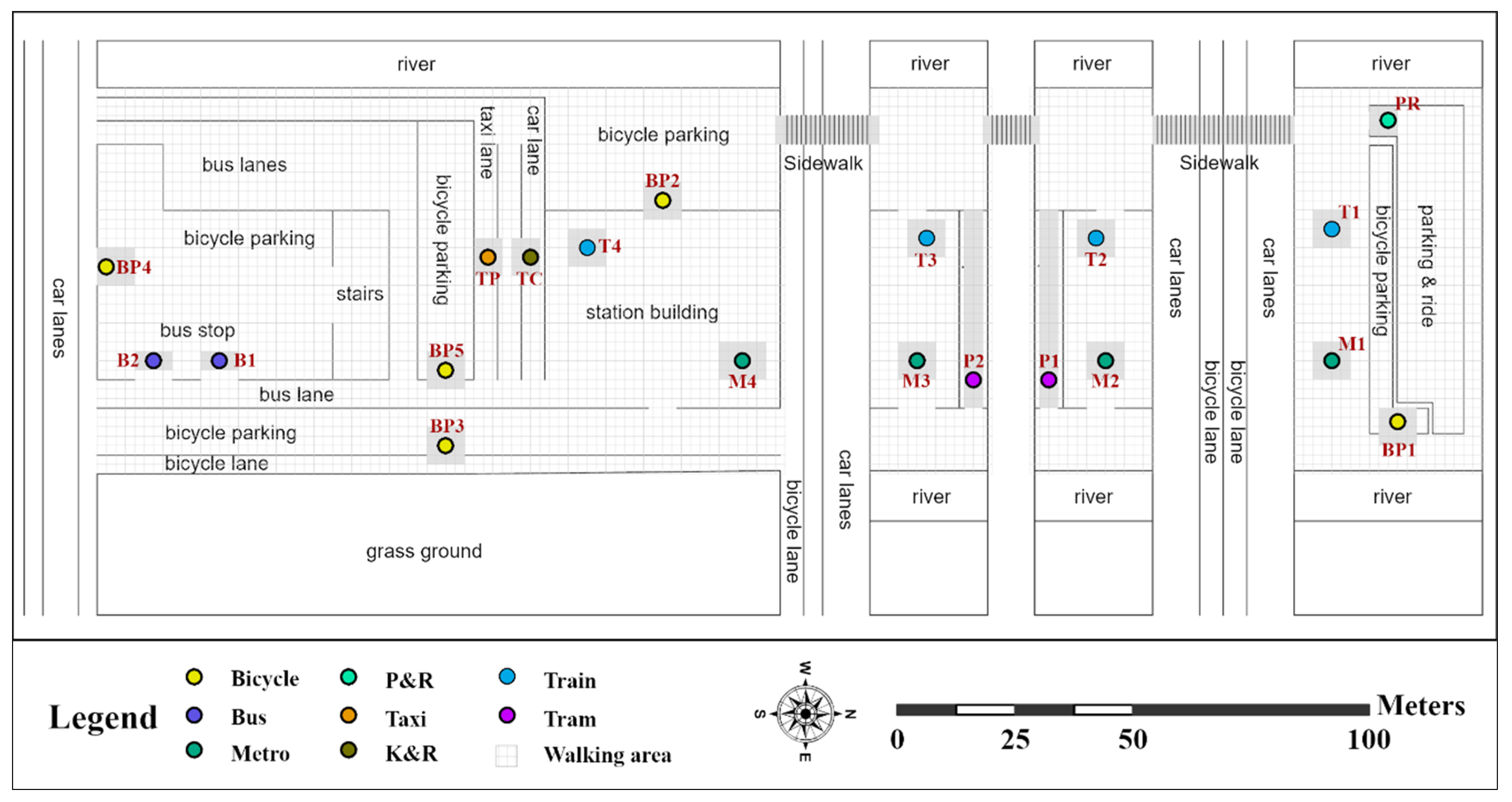
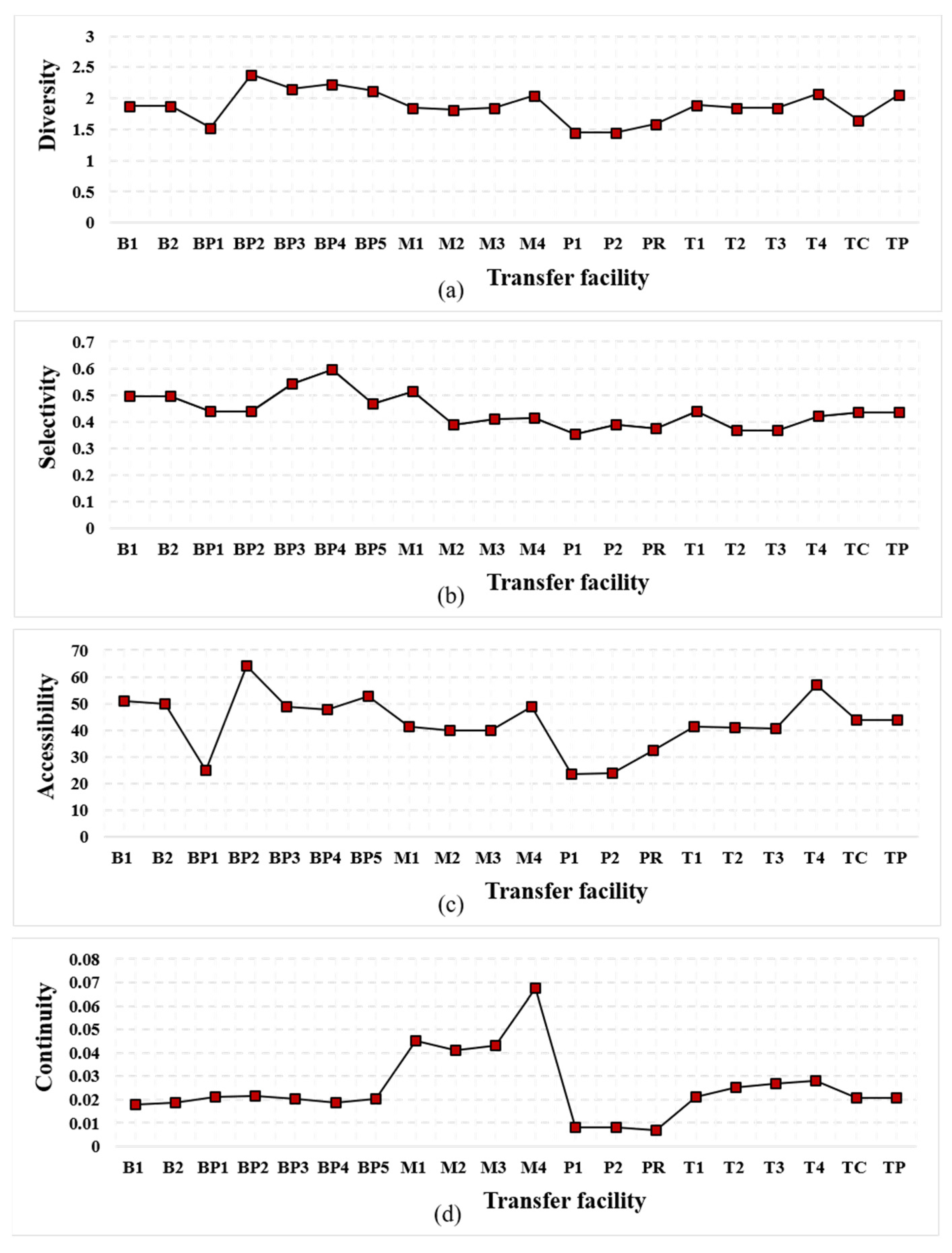
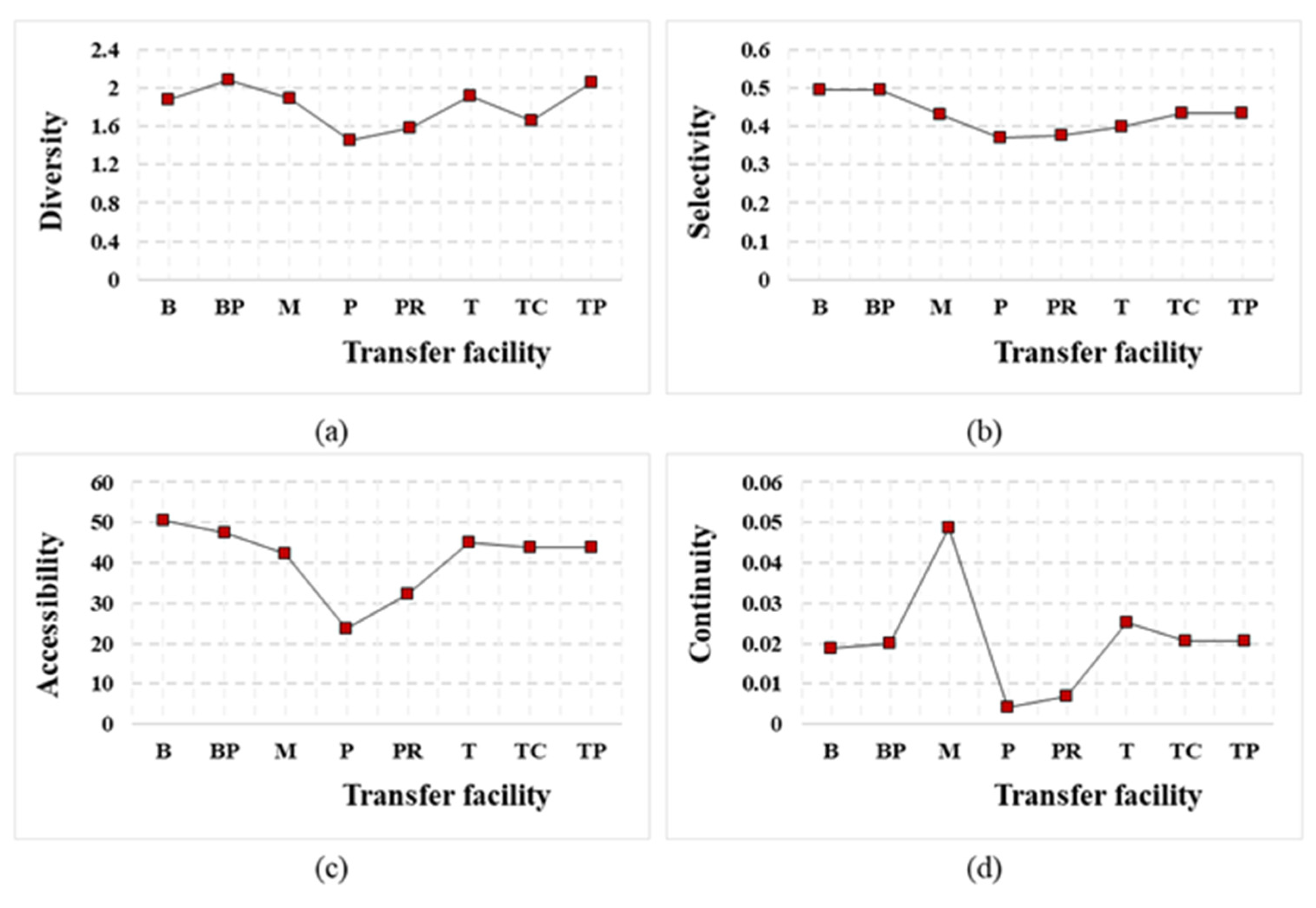
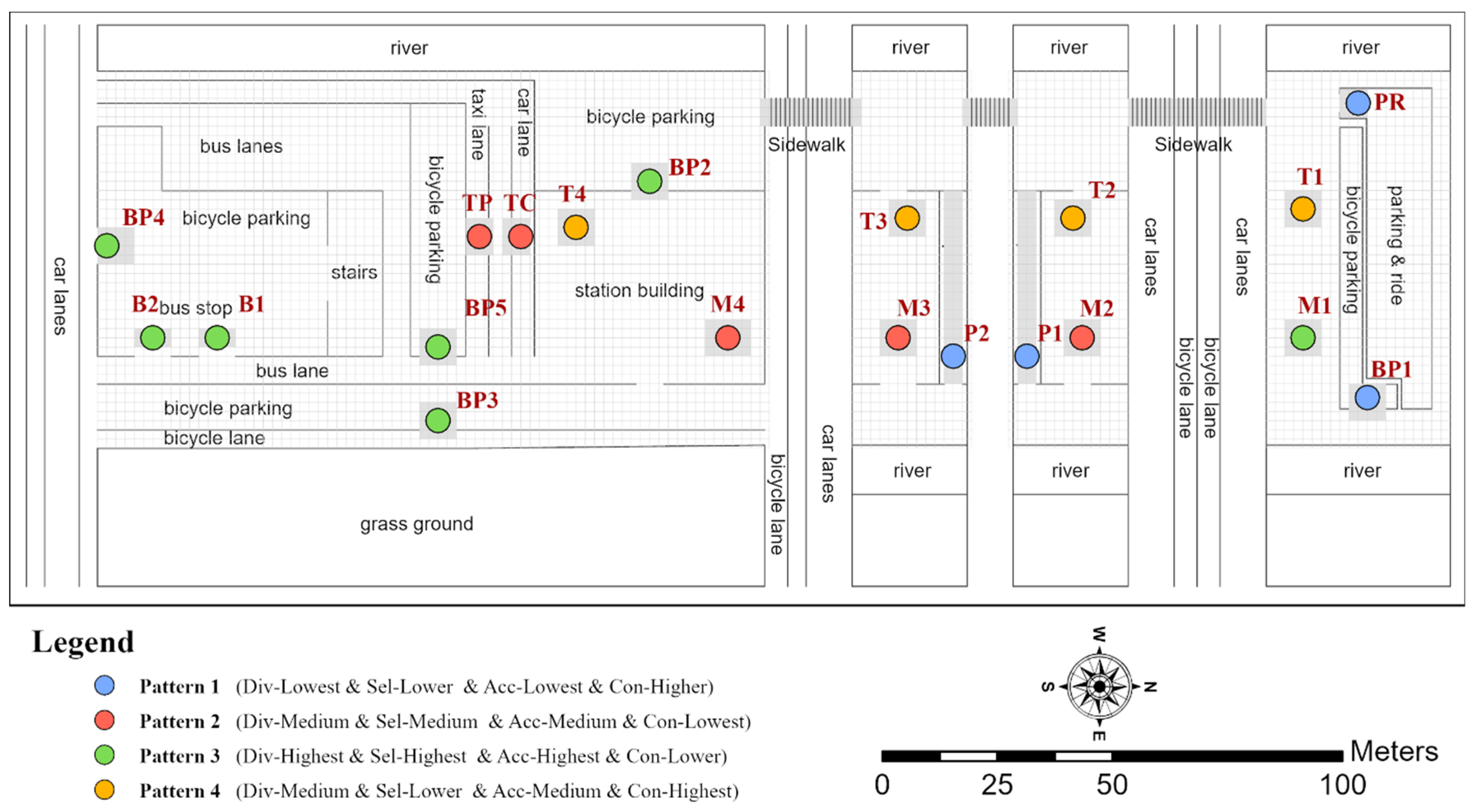
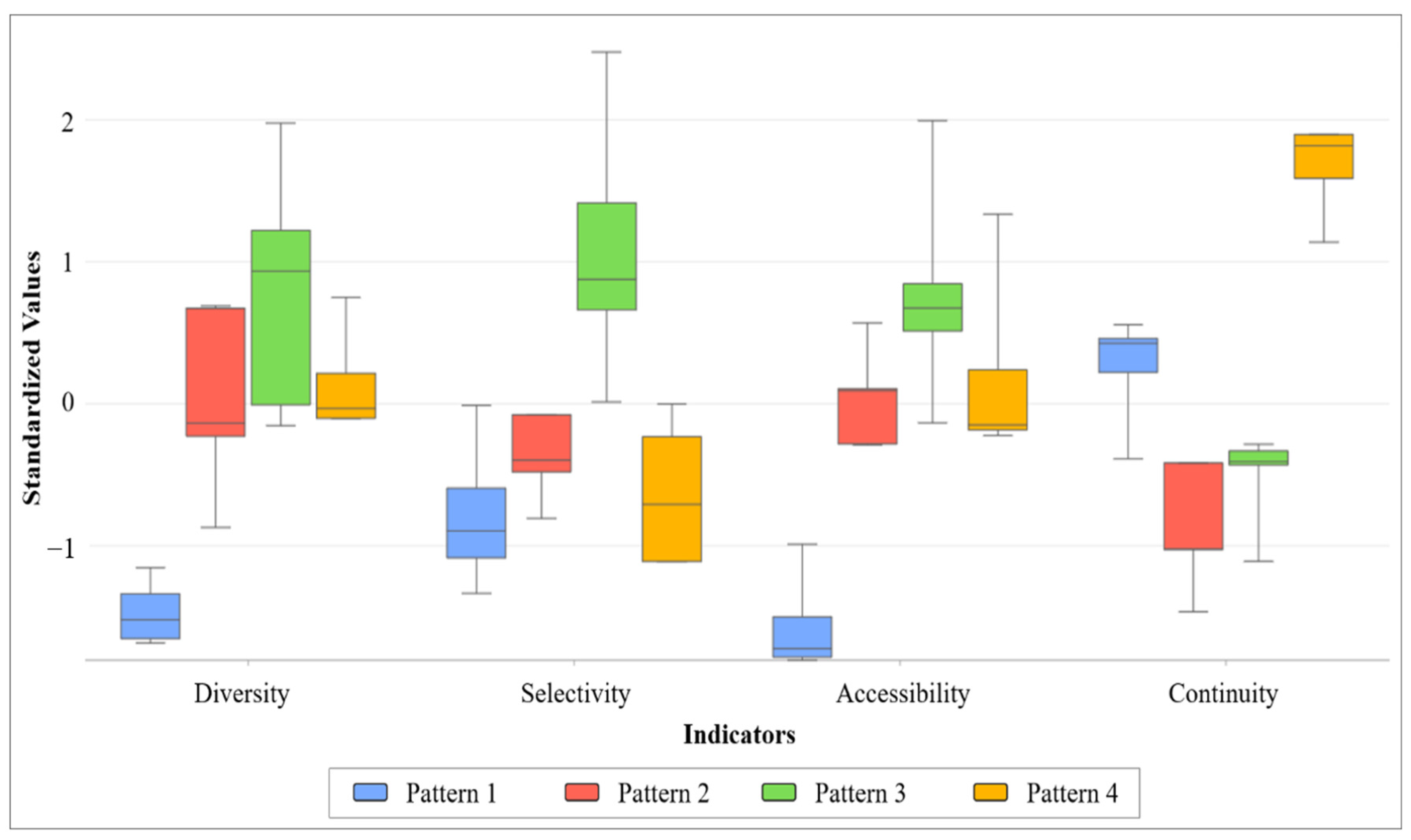

| Step | Formula | Remarks |
|---|---|---|
| 2. The proportion of the sample i value of indicator j | ||
| 3. Calculation of entropy value e of indicator j | ||
| 4. Calculation of information entropy redundancy d | is, the more important the indicator is. | |
| 5. Calculation of the weight w of each indicator | ||
| 6. Calculation of the comprehensive score of each sample |
| Transfer Facility | Abbreviation Code | Transfer Facility | Abbreviation Code |
|---|---|---|---|
| Metro | M1, M2, M3, M4 | B&R | BP1, BP2, BP3, BP4, BP5 |
| Bus | B1, B2 | P&R | PR |
| Train | T1, T2, T3, T4 | Tram | P1, P2 |
| Taxi | TP | K&R | TC |
| Indicator Type | Diversity | Selectivity | Accessibility | Continuity |
|---|---|---|---|---|
| Entropy weight | 0.926 | 0.929 | 0.908 | 0.903 |
| Transfer Facility | B1 | B2 | BP1 | BP2 | BP3 | BP4 | BP5 |
|---|---|---|---|---|---|---|---|
| DCC-MTF | 9.32 | 9.57 | 6.17 | 12.68 | 8.59 | 8.53 | 10.57 |
| Mean DCC-MTF | 9.45 | 9.31 | |||||
| Transfer Facility | M1 | M2 | M3 | M4 | P1 | P2 | PR |
| DCC-MTF | 9.62 | 9.15 | 9.06 | 9.46 | 7.01 | 6.75 | 6.9 |
| Mean DCC-MTF | 9.07 | 6.88 | 6.90 | ||||
| Transfer Facility | T1 | T2 | T3 | T4 | TC | TP | —— |
| DCC-MTF | 5.30 | 7.92 | 10.06 | 10.49 | 10.30 | 10.83 | |
| Mean DCC-MTF | 9.44 | 10.30 | 10.83 | ||||
Publisher’s Note: MDPI stays neutral with regard to jurisdictional claims in published maps and institutional affiliations. |
© 2022 by the authors. Licensee MDPI, Basel, Switzerland. This article is an open access article distributed under the terms and conditions of the Creative Commons Attribution (CC BY) license (https://creativecommons.org/licenses/by/4.0/).
Share and Cite
Chen, L.; Zhang, H.; Lu, W. Assessment of the Interconnection for Multi-Transfer Facilities: A Perspective from Coupling Coordination. Sustainability 2022, 14, 5803. https://doi.org/10.3390/su14105803
Chen L, Zhang H, Lu W. Assessment of the Interconnection for Multi-Transfer Facilities: A Perspective from Coupling Coordination. Sustainability. 2022; 14(10):5803. https://doi.org/10.3390/su14105803
Chicago/Turabian StyleChen, Lijun, Haiping Zhang, and Weike Lu. 2022. "Assessment of the Interconnection for Multi-Transfer Facilities: A Perspective from Coupling Coordination" Sustainability 14, no. 10: 5803. https://doi.org/10.3390/su14105803






